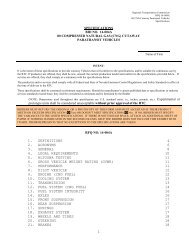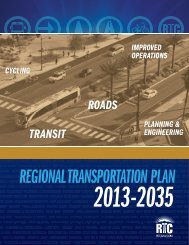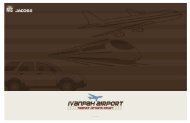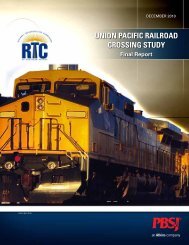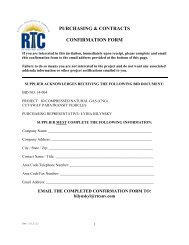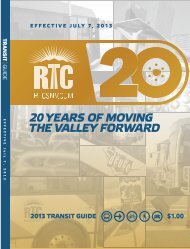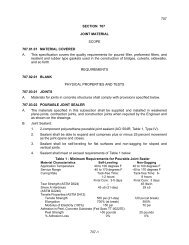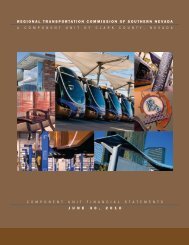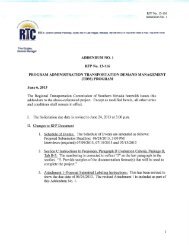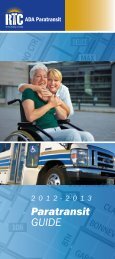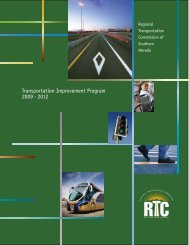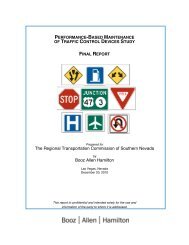(Blue Diamond Road) Corridor Study - Regional Transportation ...
(Blue Diamond Road) Corridor Study - Regional Transportation ...
(Blue Diamond Road) Corridor Study - Regional Transportation ...
You also want an ePaper? Increase the reach of your titles
YUMPU automatically turns print PDFs into web optimized ePapers that Google loves.
3. Overview of Transit Modes RTC SR-160 <strong>Corridor</strong> <strong>Study</strong><br />
3.3.4 Service Characteristics<br />
LRT/DMU systems typically operate 10 to 15 minute peak headways during weekday service<br />
and accommodate relatively tightly spaced stations, allowing for short and moderate length<br />
trips. LRT/DMU systems allow for more efficient high-volume boarding than conventional<br />
buses because they can accommodate level boarding from a station platform and typically<br />
require fare pre-payment. Most properties operate LRT/DMU service between 18-20 hours<br />
per weekday. Most of the new LRT/DMU systems built in the United States over the past<br />
quarter century range between 8 and 26 miles in route length.<br />
Research on transit ridership in cities with new LRT/DMU systems suggests that these<br />
systems, when implemented appropriately, have the potential to enhance transit efficiency.<br />
A <strong>Transportation</strong> Research Board (TRB) report published in November 2000 found that new<br />
LRT systems accounted for 22 percent of total system boardings and carried 30 percent of<br />
systemwide passenger miles but consumed only 17 percent of the operating and<br />
maintenance costs.<br />
While LRT/DMU has the potential to achieve significant efficiencies, it is worth noting that<br />
the cost of wayside maintenance, stations, electrification, signals and other fixed facilities<br />
are quite substantial. Achieving scale economies for LRT/DMU requires high ridership, and<br />
the presence of high-density transit friendly corridors that can anchor radial lines and<br />
crosstown bus feeder routes.<br />
3.3.5 Capital Costs<br />
FTA’s Light Rail Transit Capital Cost <strong>Study</strong> subdivides LRT capital costs into eight individual<br />
cost components.<br />
<br />
<br />
<br />
<br />
<br />
<br />
<br />
<br />
<br />
<br />
Guideway<br />
Trackwork<br />
Systems<br />
Stations<br />
Facilities<br />
Vehicles<br />
Special Conditions<br />
Right-of-Way<br />
Soft Costs: Engineering/Design/Project & Construction Management and Insurance<br />
Contingency<br />
3-15



